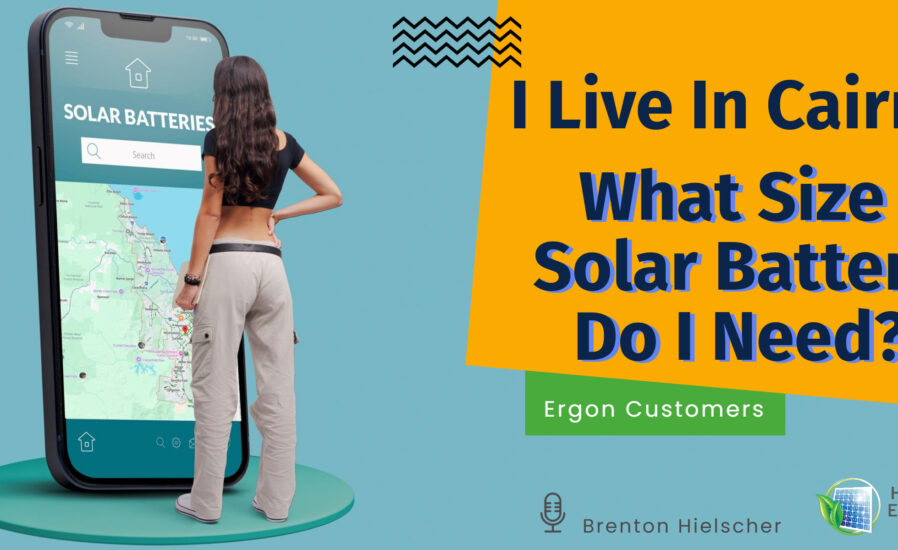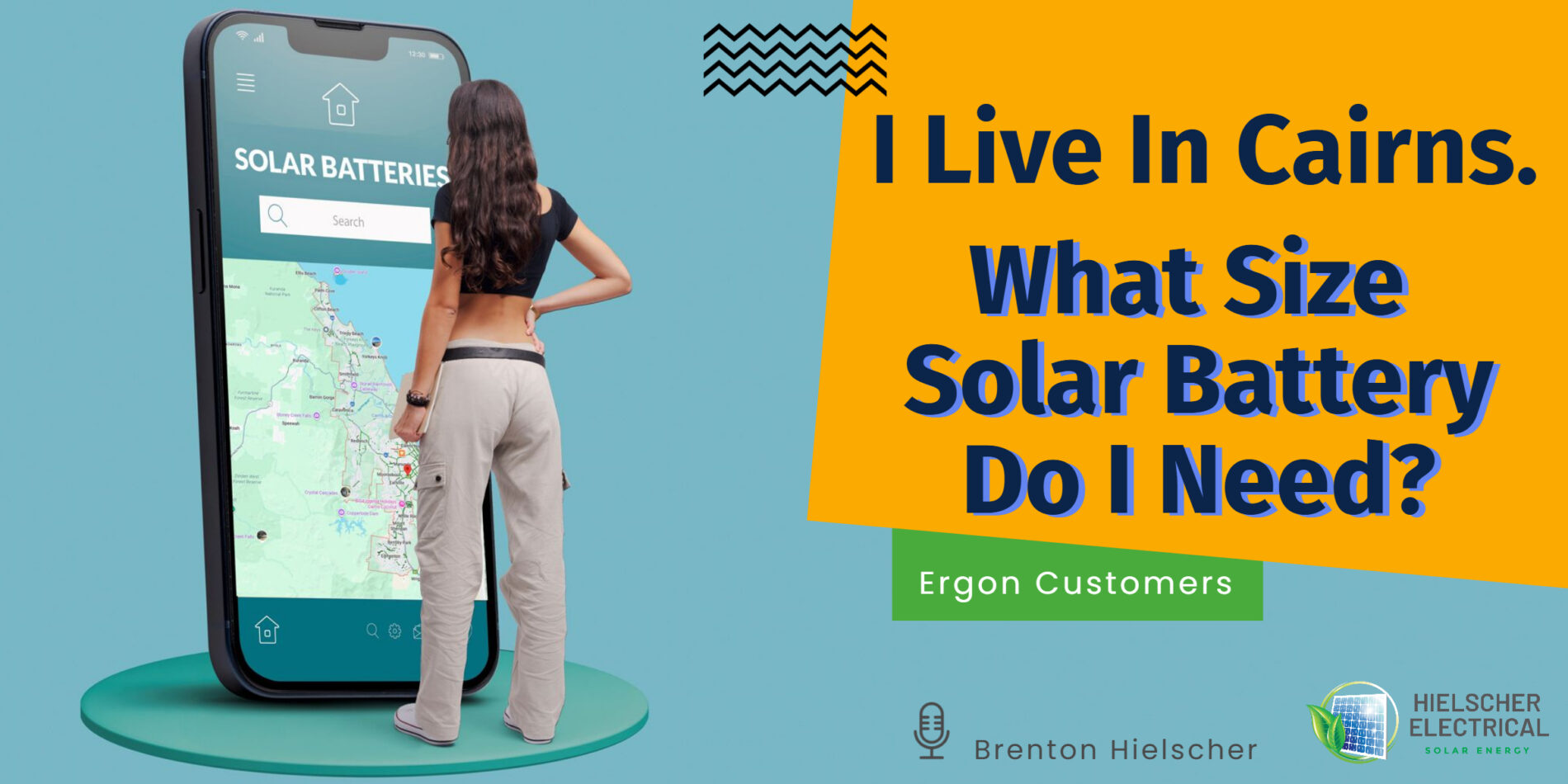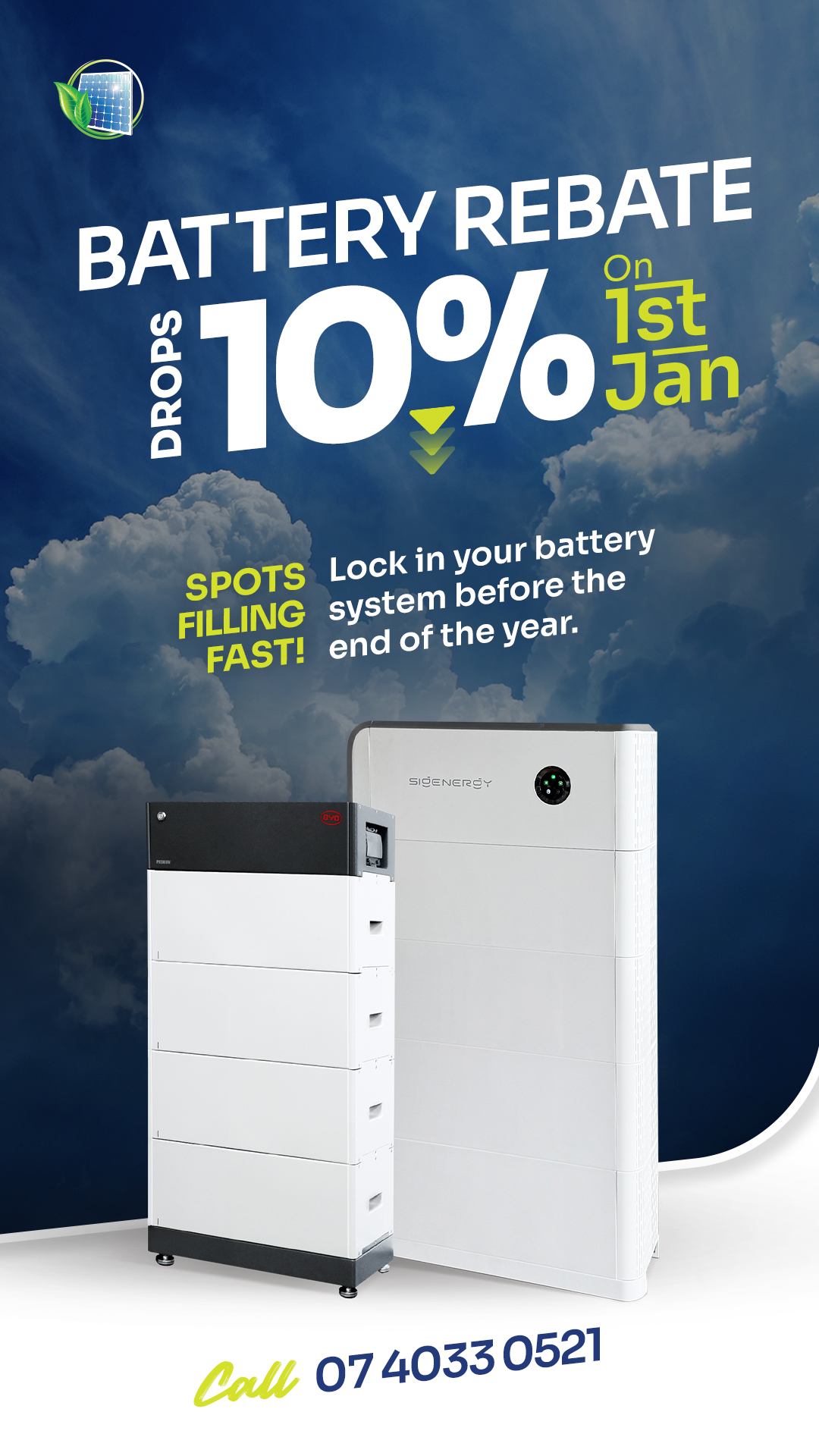
As a lifelong North Queenslander and a solar professional with years on the tools, I’ve seen firsthand how our climate shapes North Queensland’s energy needs. The blistering heat, the humidity and the ever-present risk of cyclonic activity mean that for Cairns homeowners, a solar battery isn’t just about saving a few bucks – it’s about comfort, resilience and genuine energy independence. With the Cheaper Solar Batteries rebates now three months in and driving serious savings, it’s also the best time in years to right-size a system for your home and budget.
But with so many options, the question I hear most often is: “What size solar battery do I actually need for my Cairns home?” It’s a crucial question, and the answer isn’t one-size-fits-all. It requires a thoughtful assessment of your energy habits, your priorities and the specific demands our tropical environment places on your system. Forget the generic advice you might find online; let’s dive into what truly matters for Cairns.
Short answer: it depends on your evening usage, backup priorities, and how your PV system performs through our wet season. Below, I’ll walk you through a Cairns-specific approach that I use on real jobs, plus quick rules of thumb you can apply right away.
Quick battery sizing snapshot (Cairns edition)
- 6.6 kW solar → 10–15 kWh usable battery suits most families focused on bill savings.
- 8–10 kW solar → 15–20 kWh usable battery if you want deeper evening coverage or partial A/C during heatwaves.
- Backup only (essentials) → 5–10 kWh usable for lights, fridge, fans, modem and charging.
- Backup incl. a couple of split systems → 20–30+ kWh usable plus an inverter sized to start and run the A/Cs.
Big tip: Always size to usable capacity (what you can actually draw), not just the sticker (gross) capacity.
Beyond the sales pitch: understanding usable capacity
Before we talk numbers, let’s clarify a fundamental point: usable capacity. When you see a battery advertised as 10 kWh, that’s its total, gross capacity. Most modern lithium batteries protect their lifespan by keeping a buffer at the top or bottom of the charge, so you can’t tap 100% day-to-day. Usable capacity is the figure that actually matters for your bills and backup. It should be clearly quoted by your installer, along with expected round-trip efficiency and recommended depth of discharge so you know exactly what you’re getting.
Step 1: unearthing your energy footprint – the Cairns reality
The starting point for accurate battery sizing is understanding your current consumption, and in Cairns that’s a seasonal story. Your electricity bill is gold. Check the “Average Daily Consumption” in kWh and compare summer (December–February) with winter (June–August). For many homes, air conditioning doubles summer usage, so a tidy 15 kWh/day in the dry can quickly become 30 kWh/day when the humidity hits. Remember that while your solar panels work hard in daylight, much of a family’s demand shifts to the evening – cooking, lights, entertainment and cooling bedrooms. Sizing a battery to cover your typical evening load is the fastest path to lower bills and better comfort.
Quick method:
- Take your daily kWh from a warm-weather bill.
- Multiply by 0.5–0.7 (many homes use 50–70% at night).
- That’s a starting target for usable battery capacity if your goal is bill savings.
Example: 28 kWh/day × 0.6 ≈ 17 kWh evening usage → aim for ~13–17 kWh usable battery to cover most nights.
Step 2: defining your “why” – maximising savings vs powering through outages
Your primary motivation dictates the right size and configuration. If your goal is financial return and self-consumption, you’re aiming to store excess solar from the day and use it during the evening peak instead of buying grid power at higher peak tariff rates. A practical way to estimate size is to take your daily kWh from a warm-weather bill and ask how much of that you use between about 5 pm and 10 pm. If you’re using 25 kWh/day and around 60% of that is after sunset, a battery with roughly 10–14 kWh of usable capacity usually covers the bulk of your evening loads and brings a strong bill impact without overcapitalising.
If your focus is blackout protection and cyclone resilience, the conversation shifts to essential circuits and autonomy. You’re unlikely to power the entire home for days, so identify the must-haves: fridge, a few lights, ceiling fans, modem and phone charging, plus any medical equipment. For many Cairns households, designing for 24–48 hours of intermittent use is sensible, assuming some daytime solar top-up even in the wet. If your essential loads average about 1.5 kW, a minimum usable capacity of 5–8 kWh keeps the basics going. If you also want to run one or two efficient split systems during outages, plan for significantly more capacity – often 15–20 kWh or more – and ensure your inverter can handle both the continuous power and the start-up surge those compressors demand. This is where a dedicated backup circuit and a fast-changeover (UPS-style) hybrid inverter make all the difference.
Important: Capacity (kWh) is different to power (kW). Your inverter must be sized to start motors (fridge, A/C) and run them continuously.
Step 3: pairing with your solar PV system – the symbiotic relationship
A battery can only charge from surplus energy your panels produce after daytime usage. In Cairns, with excellent irradiance but regular cloud events in the wet, a slightly oversized PV array keeps your battery fed year-round. For many family homes, 6.6 kW of solar pairs well with around 10–13 kWh of usable storage if savings are the main goal. If you’ve got roof space and want deeper evening coverage or partial air conditioning, 8–10 kW of PV with 13–20 kWh of usable storage is a solid match. As a simple guide, target roughly 1.5 to 2 kWh of usable battery capacity for every 1 kW of panels, adjusted to your habits and roof constraints.
Wet season reality: Expect slower charges on grey days; oversizing PV helps keep the battery topped.
North Queensland’s unique climate: beyond the numbers
Design matters as much as the math’s. Batteries hate heat, so placement is critical. A west-facing wall, a hot tin shed or a tight, unventilated cupboard will shorten life and performance. Choose shaded, well-ventilated locations or suitable indoor spots that meet the manufacturer’s guidelines. In our climate I strongly favour Lithium Iron Phosphate (LFP) chemistry for its thermal stability, long cycle life and safer behaviour under stress. Installation should be cyclone-ready with appropriate fixings, clearances and weatherproofing, because salt air and sideways rain are just part of life up here. Be realistic about the wet season as well – extended cloud cover slows charging, which reinforces the value of essential-load selection during outages and a PV array sized to recover the battery on the next sunny break.
The Cheaper Solar Batteries Rebate Boost:
We’re a few months into the new Cheaper Solar Batteries rebates and they’re driving serious savings for Cairns homeowners adding storage. If you’ve been on the fence, this is genuinely the best window we’ve seen in years.
- We can check your eligibility, estimate your out-of-pocket, and design a system that hits your goals (savings, backup, or both).
- We also help with the paperwork so you don’t miss out.
Ask us to run your rebate eligibility and payback numbers — Follow the link below then send through a photo/PDF of your last 2 power bills and a snap of your switchboard.
Get your rebate eligibility and payback numbers
Making the right choice for your home
The right battery size in Cairns is less about a headline number and more about tailoring to your lifestyle, your roof and your priorities. For many homeowners focused on bills, a usable 20–30 kWh paired with 8–13 kW of solar hits the sweet spot. For those chasing blackout comfort, step up capacity, choose an inverter with genuine backup grunt and wire a proper essential-loads circuit. With the Cheaper Solar Batteries rebates now well underway and driving substantial savings across Far North Queensland, there’s real momentum to get this done right.
My advice is to use this guide as a foundation, then bring your electricity bills and your questions to the team and I at Hielscher Electrical, your local SAA-accredited experts who understand Cairns and Far North Queensland conditions. I’ll come back with a right-sized design, a rebate eligibility check and clear pricing options – built tough for North Queensland and ready for the next wet.
Get your FREE solar battery design proposal
Final word (and a friendly nudge)
I’m Brenton from Hielscher Electrical and Solar. We’ve helped hundreds of FNQ homeowners get reliable, resilient solar + batteries. If you’re in Cairns or surrounds, I’d be stoked to help you next. 💪🌞






Great insights here! I completely agree that choosing the right solar battery size really depends on your individual energy habits and how you use power through those hot Cairns evenings. The solar battery rebate has definitely made it the perfect time to consider upgrading or installing a new system, especially with trusted local teams like KDEC making the process smooth and stress-free. Thanks for the info!
BTW, have you noticed more homeowners in Cairns starting to invest in solar storage lately?